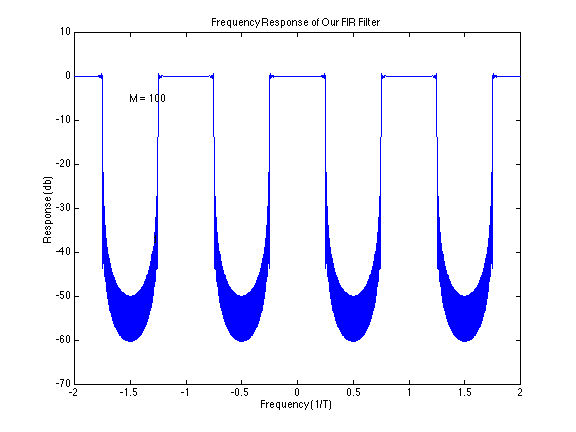FIR Filter Example: Difference between revisions
No edit summary |
No edit summary |
||
| (5 intermediate revisions by 3 users not shown) | |||
| Line 1: | Line 1: | ||
*[[Signals and systems|Signals and Systems]] |
|||
The filter coefficients are given by: |
The filter coefficients are given by: |
||
<math> |
<math> |
||
h_m = { T } \int_{-{1\over 4T}}^{{1\over 4T}} H(f)e^{j2\pi m f T}\,df |
h_m = { T } \int_{-{1\over 4T}}^{{1\over 4T}} H(f)e^{j2\pi m f T}\,df |
||
</math> |
</math> |
||
where H(f) is the desired frequency response. See the notes |
where H(f) is the desired frequency response. See the notes from October 31, 2005. As an example of this filter we will make a Matlab script that will computer the frequency response for a low pass filter having a cutoff frequency of 1/(4T), and using 2M+1 coefficients. Note that it is periodic with period 1/T. This is the case with all digital filters. |
||
Here is the plot the Matlab code produces: |
|||
[[Image:Frequency_Response_Pict.png]] |
|||
The Matlab code to see the frequency response is given below: |
The Matlab code to see the frequency response is given below: |
||
| Line 23: | Line 28: | ||
for m=-M:M; |
for m=-M:M; |
||
: if m==0 |
|||
h=1/2; |
:: h=1/2; |
||
: else |
|||
h=sin(pi*m/2)/(pi*m); |
:: h=sin(pi*m/2)/(pi*m); |
||
: end |
|||
: sum=sum+h*exp(-i*2*pi*f*m*T); |
|||
end |
end |
||
Latest revision as of 09:36, 1 October 2008
The filter coefficients are given by: where H(f) is the desired frequency response. See the notes from October 31, 2005. As an example of this filter we will make a Matlab script that will computer the frequency response for a low pass filter having a cutoff frequency of 1/(4T), and using 2M+1 coefficients. Note that it is periodic with period 1/T. This is the case with all digital filters.
Here is the plot the Matlab code produces:
The Matlab code to see the frequency response is given below:
% This shows how to find the frequency response for an FIR filter with cutoff 1/4/T and 2M+1 coefficients.
clf;
sum=0;
T=1;
fs=1/1000/T;
f=-2/T:fs:2/T
M=100;
for m=-M:M;
- if m==0
- h=1/2;
- else
- h=sin(pi*m/2)/(pi*m);
- end
- sum=sum+h*exp(-i*2*pi*f*m*T);
end
plot(f,20*log10(abs(sum)))
title('Frequency Response of Our FIR Filter')
xlabel('Frequency (1/T)')
ylabel('Response (db)')
text(-1.5,-5,'M = 100')
% End of Matlab code.

